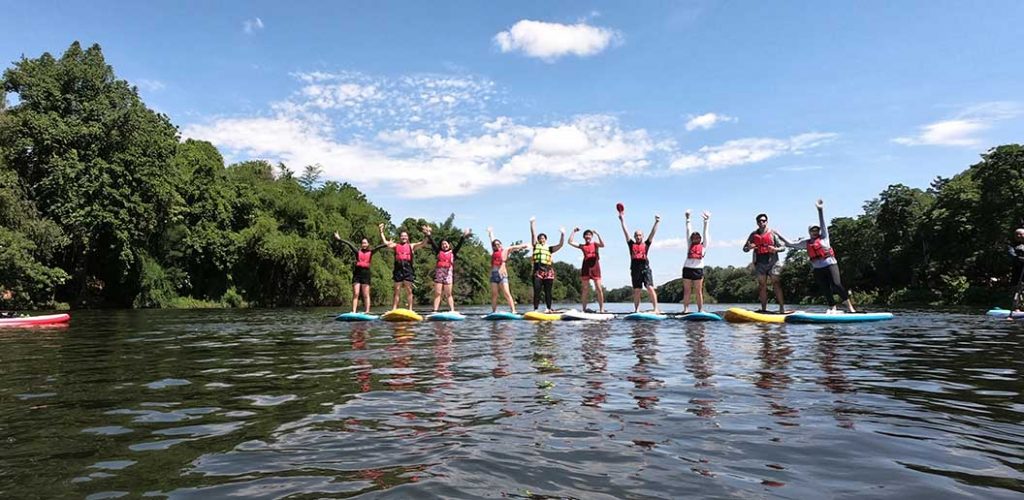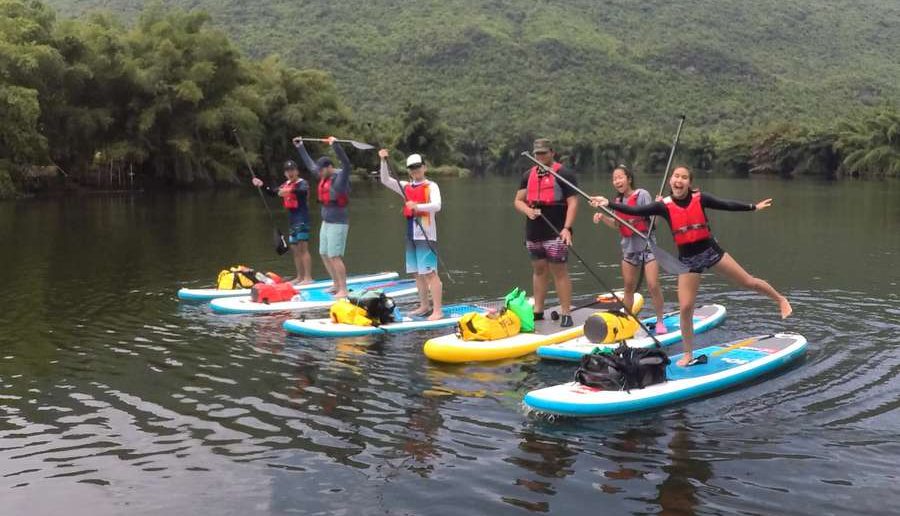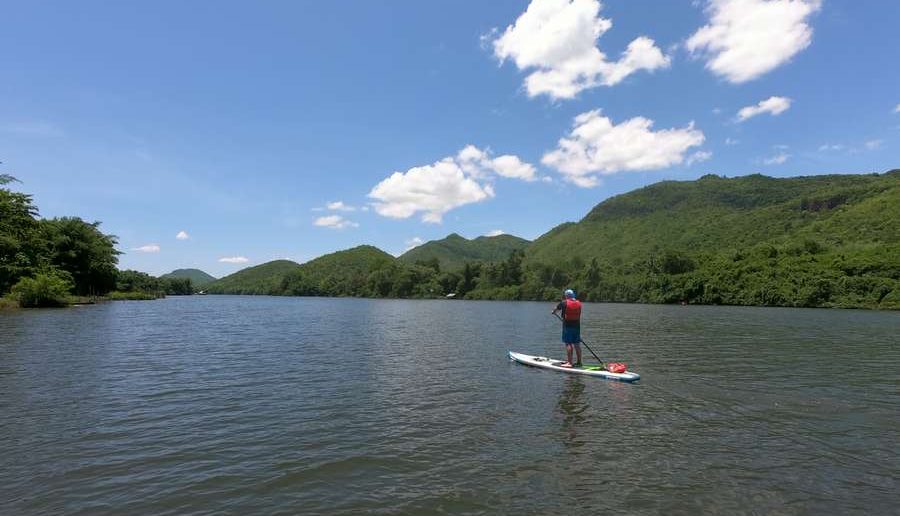There are a lot of reasons why Kanchanaburi is a popular destination for weekend getaways from the city. 150 km from Bangkok, Kanchanaburi is small but packed with hidden gems—from historical sites to natural wonders. There are really many things to do here—some of them are quite touristy while others are more off the beaten track. To get the best of what Kanchanaburi has to offer, Stand Up Paddleboard (SUP) Hire (Thailand), Co., Ltd. based in Kanchanaburi definitely hits the mark.
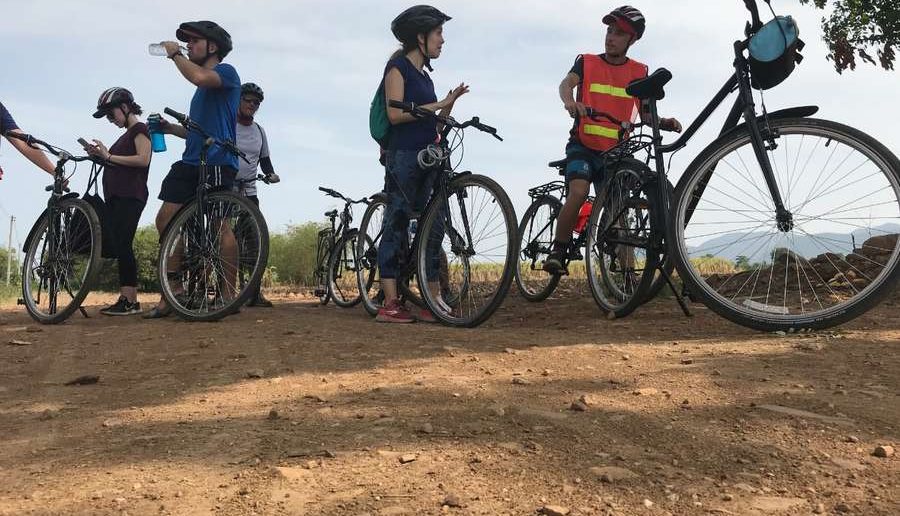 SUP aims to provide fun and safe lessons and experiences, not just paddle-boarding but cycling as well. They offer a range of activities which take you onto various sections of the River Kwai, depending on your age, level of experience and available times, from early morning to late afternoon. Their large fleet of 6-speed hybrid bicycles is well-maintained to tour the local areas, through rice and sugarcane fields with a multitude of wildlife and birdlife to be seen in between. It is to be noted that SUP is not a tour company. They teach all the skills of stand up paddle-boarding and it is of good fortune that they do that in the beautiful, tranquil environment of the famous River Kwai.
SUP aims to provide fun and safe lessons and experiences, not just paddle-boarding but cycling as well. They offer a range of activities which take you onto various sections of the River Kwai, depending on your age, level of experience and available times, from early morning to late afternoon. Their large fleet of 6-speed hybrid bicycles is well-maintained to tour the local areas, through rice and sugarcane fields with a multitude of wildlife and birdlife to be seen in between. It is to be noted that SUP is not a tour company. They teach all the skills of stand up paddle-boarding and it is of good fortune that they do that in the beautiful, tranquil environment of the famous River Kwai.
 Most people that try stand up paddle-boarding for the first time are surprised at how easy it is. Even then, with a motto of “Value and Trust”, it’s no false promise that SUP uses quality boards with a dedicated and exceptionally qualified team of instructors. Their ideology stems further as there is more to outdoor education than just learning skills—SUP also prioritizes your knowledge of safety, rescue, equipment and above all, respecting nature and the river while on the water. With their focus on nature, teamwork and responsibility, it is no wonder that a number of companies come to SUP for team-building and they welcome students from several established international schools in the region as well. Quoting SUP, “We are delighted to give everyone a break from technology and being ‘connected’ – the only connection you’ll experience is with the board, the river, those around you and with nature. It’s a very meditative experience that engages your whole body and everyone can do it.”
Most people that try stand up paddle-boarding for the first time are surprised at how easy it is. Even then, with a motto of “Value and Trust”, it’s no false promise that SUP uses quality boards with a dedicated and exceptionally qualified team of instructors. Their ideology stems further as there is more to outdoor education than just learning skills—SUP also prioritizes your knowledge of safety, rescue, equipment and above all, respecting nature and the river while on the water. With their focus on nature, teamwork and responsibility, it is no wonder that a number of companies come to SUP for team-building and they welcome students from several established international schools in the region as well. Quoting SUP, “We are delighted to give everyone a break from technology and being ‘connected’ – the only connection you’ll experience is with the board, the river, those around you and with nature. It’s a very meditative experience that engages your whole body and everyone can do it.”
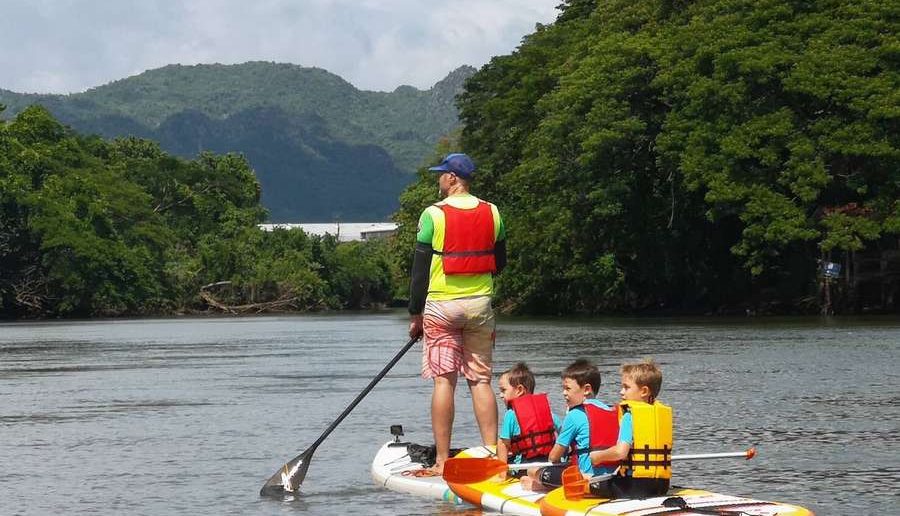 They’re not joking; unlike other board sports, stand up paddle boarding doesn’t take much technical skill. Unlike kite boarding or kayaking, which require more equipment or are big and bulky, a SUP board is not too heavy and is relatively easy to transport. The paddler typically stands (or kneels) on the board and propulsion is via a single paddle. It can be done on any body of water including rivers, lakes and seas and is not only a lot of fun, but also has great health benefits. Now the benefits start from balance, not just on the board but also in day-to-day activities outside the water. It provides the paddler with a full body workout because almost every muscle in the body is used at some point during paddle boarding. If you are weak or healing from an injury to your muscles and joints, paddle boarding is an excellent exercise to gently increase strength without doing any harm.
They’re not joking; unlike other board sports, stand up paddle boarding doesn’t take much technical skill. Unlike kite boarding or kayaking, which require more equipment or are big and bulky, a SUP board is not too heavy and is relatively easy to transport. The paddler typically stands (or kneels) on the board and propulsion is via a single paddle. It can be done on any body of water including rivers, lakes and seas and is not only a lot of fun, but also has great health benefits. Now the benefits start from balance, not just on the board but also in day-to-day activities outside the water. It provides the paddler with a full body workout because almost every muscle in the body is used at some point during paddle boarding. If you are weak or healing from an injury to your muscles and joints, paddle boarding is an excellent exercise to gently increase strength without doing any harm.
 After spending a day out on a paddleboard, you might feel tired and even a little sore, but it is a good soreness that shows you that you have used your muscles and built up your overall body strength. According to isupworld.com, paddle boarding will help you avoid being a victim of heart attacks and strokes. Not only will you have improved cardiovascular health, you also improve endurance. Above all, being out on the water is calming, and engaging with nature can have a positive effect on your mental health and attitude. In addition, getting some extra vitamin D from the sun is good for you, providing you don’t get sunburn.
After spending a day out on a paddleboard, you might feel tired and even a little sore, but it is a good soreness that shows you that you have used your muscles and built up your overall body strength. According to isupworld.com, paddle boarding will help you avoid being a victim of heart attacks and strokes. Not only will you have improved cardiovascular health, you also improve endurance. Above all, being out on the water is calming, and engaging with nature can have a positive effect on your mental health and attitude. In addition, getting some extra vitamin D from the sun is good for you, providing you don’t get sunburn.
 With that in mind, SUP offers various adventurous journeys and expeditions along the River Kwai Yai or Kwai Noi, which under controlled guidelines can count toward the Duke of Edinburgh’s International Award. The award is a youth development program, made for the empowerment of youths and to find their purpose, passion and place in the world, regardless of their location or circumstances. SUP can provide Bronze, Silver or Gold level Adventurous Journeys by SUP, along with Bronze Level hikes in stunning rural Kanchanaburi. The instructors, guided by the chief SUP instructor Troy, senior and lead SUP instructors Hojeong and Pep, and medical team member Peng, are flexible and meticulous – dedicated to providing the best of experiences.
With that in mind, SUP offers various adventurous journeys and expeditions along the River Kwai Yai or Kwai Noi, which under controlled guidelines can count toward the Duke of Edinburgh’s International Award. The award is a youth development program, made for the empowerment of youths and to find their purpose, passion and place in the world, regardless of their location or circumstances. SUP can provide Bronze, Silver or Gold level Adventurous Journeys by SUP, along with Bronze Level hikes in stunning rural Kanchanaburi. The instructors, guided by the chief SUP instructor Troy, senior and lead SUP instructors Hojeong and Pep, and medical team member Peng, are flexible and meticulous – dedicated to providing the best of experiences.
 SUP’s affinity to nature extends to the stunning (and clean) rivers and waterways of Kanchanaburi. They support the reuse of water bottles and ask that their customers do the same by bringing refillable water bottles. The effort is well-rewarded once you go through their carefully planned routes, which displays the best of what Kanchanaburi has to offer, from cycling along its beautiful tracks to paddle boarding along its luscious rivers. So, whether you want to try paddle boarding for the first time or develop your existing skills or even if you just want to float in the water and focus on the stunning scenery, SUP will take care of you. So bring along a change of clothes, slap on some sunscreen and you’ll be good to go. SUP Hire (Thailand) will take care of the rest.
SUP’s affinity to nature extends to the stunning (and clean) rivers and waterways of Kanchanaburi. They support the reuse of water bottles and ask that their customers do the same by bringing refillable water bottles. The effort is well-rewarded once you go through their carefully planned routes, which displays the best of what Kanchanaburi has to offer, from cycling along its beautiful tracks to paddle boarding along its luscious rivers. So, whether you want to try paddle boarding for the first time or develop your existing skills or even if you just want to float in the water and focus on the stunning scenery, SUP will take care of you. So bring along a change of clothes, slap on some sunscreen and you’ll be good to go. SUP Hire (Thailand) will take care of the rest.
Sup History
The history of stand-up paddle boarding traces back thousands of years ago and across many continents, but its current form and popularity originated in Hawaii in the 1900s. In the 1940s, surf instructors in Waikiki like Duke Kahanamoku and Leroy and Bobby AhChoy would take paddles and stand on their boards to get a better view of the surfers in the water and incoming swells, and from time to time they would surf the waves using the paddle to steer the board. Injured in a car accident that restricted him from swimming or kneeling, Bobby would stand up, cigarettes lashed to his arm, camera about his neck, and paddle into the surf zone shouting hints to others. The AhChoy’s in turn introduced their pastime to John Zapotocky, who could certainly be considered the father of modern stand up surfing. John first went to Hawaii in 1940, and instantly fell in love with the ocean. He made his life there from that day on and after seeing Duke Kahanamoku and the other Beach boys like the AhChoy brothers on stand-up boards, he took to it and has been surfing with a paddle ever since. John rode the waves of Waikiki on a SUP board for six decades. For 60 years he would grab his board and paddle from the same rack he kept them on the majority of his lifetime until he died at 95. By 2005, SUP, which had until then been almost entirely a surfing discipline, began to diversify into racing, touring, rivers, yoga, and fishing. Its surfing heritage coupled with its various disciplines made the sport attractive and accessible to everyone all over the world, paving the way for its global growth and enthusiastic adoption.
www.supkanchanaburi.com


